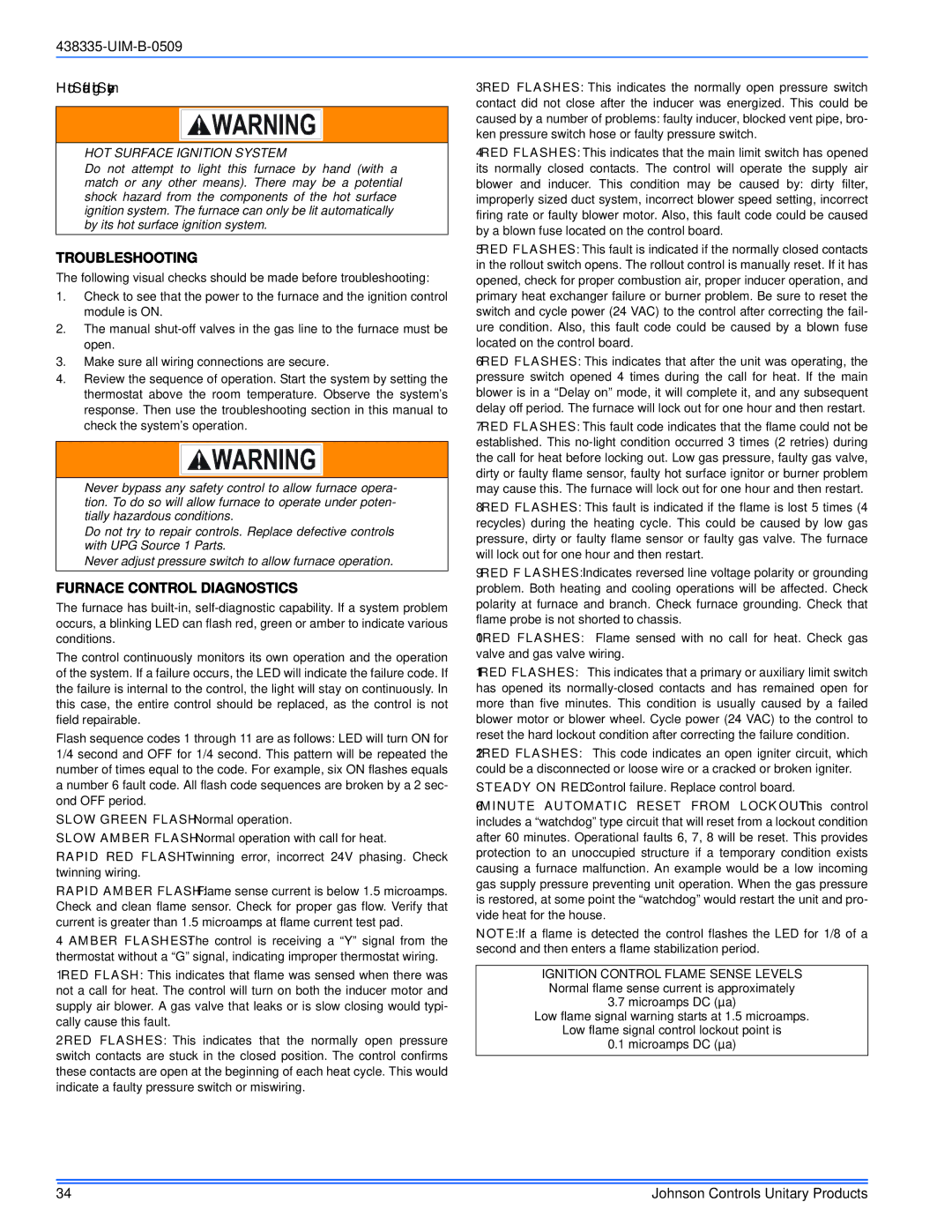Hot Surface Ignition System
HOT SURFACE IGNITION SYSTEM
Do not attempt to light this furnace by hand (with a match or any other means). There may be a potential shock hazard from the components of the hot surface ignition system. The furnace can only be lit automatically by its hot surface ignition system.
TROUBLESHOOTING
The following visual checks should be made before troubleshooting:
1.Check to see that the power to the furnace and the ignition control module is ON.
2.The manual shut-off valves in the gas line to the furnace must be open.
3.Make sure all wiring connections are secure.
4.Review the sequence of operation. Start the system by setting the thermostat above the room temperature. Observe the system’s response. Then use the troubleshooting section in this manual to check the system’s operation.
Never bypass any safety control to allow furnace opera- tion. To do so will allow furnace to operate under poten- tially hazardous conditions.
Do not try to repair controls. Replace defective controls with UPG Source 1 Parts.
Never adjust pressure switch to allow furnace operation.
FURNACE CONTROL DIAGNOSTICS
The furnace has built-in, self-diagnostic capability. If a system problem occurs, a blinking LED can flash red, green or amber to indicate various conditions.
The control continuously monitors its own operation and the operation of the system. If a failure occurs, the LED will indicate the failure code. If the failure is internal to the control, the light will stay on continuously. In this case, the entire control should be replaced, as the control is not field repairable.
Flash sequence codes 1 through 11 are as follows: LED will turn ON for 1/4 second and OFF for 1/4 second. This pattern will be repeated the number of times equal to the code. For example, six ON flashes equals a number 6 fault code. All flash code sequences are broken by a 2 sec- ond OFF period.
SLOW GREEN FLASH: Normal operation.
SLOW AMBER FLASH: Normal operation with call for heat.
RAPID RED FLASH: Twinning error, incorrect 24V phasing. Check twinning wiring.
RAPID AMBER FLASH: Flame sense current is below 1.5 microamps. Check and clean flame sensor. Check for proper gas flow. Verify that current is greater than 1.5 microamps at flame current test pad.
4 AMBER FLASHES: The control is receiving a “Y” signal from the thermostat without a “G” signal, indicating improper thermostat wiring.
3 RED FLASHES: This indicates the normally open pressure switch contact did not close after the inducer was energized. This could be caused by a number of problems: faulty inducer, blocked vent pipe, bro- ken pressure switch hose or faulty pressure switch.
4 RED FLASHES: This indicates that the main limit switch has opened its normally closed contacts. The control will operate the supply air blower and inducer. This condition may be caused by: dirty filter, improperly sized duct system, incorrect blower speed setting, incorrect firing rate or faulty blower motor. Also, this fault code could be caused by a blown fuse located on the control board.
5 RED FLASHES: This fault is indicated if the normally closed contacts in the rollout switch opens. The rollout control is manually reset. If it has opened, check for proper combustion air, proper inducer operation, and primary heat exchanger failure or burner problem. Be sure to reset the switch and cycle power (24 VAC) to the control after correcting the fail- ure condition. Also, this fault code could be caused by a blown fuse located on the control board.
6 RED FLASHES: This indicates that after the unit was operating, the pressure switch opened 4 times during the call for heat. If the main blower is in a “Delay on” mode, it will complete it, and any subsequent delay off period. The furnace will lock out for one hour and then restart.
7 RED FLASHES: This fault code indicates that the flame could not be established. This no-light condition occurred 3 times (2 retries) during the call for heat before locking out. Low gas pressure, faulty gas valve, dirty or faulty flame sensor, faulty hot surface ignitor or burner problem may cause this. The furnace will lock out for one hour and then restart.
8 RED FLASHES: This fault is indicated if the flame is lost 5 times (4 recycles) during the heating cycle. This could be caused by low gas pressure, dirty or faulty flame sensor or faulty gas valve. The furnace will lock out for one hour and then restart.
9 RED FLASHES: Indicates reversed line voltage polarity or grounding problem. Both heating and cooling operations will be affected. Check polarity at furnace and branch. Check furnace grounding. Check that flame probe is not shorted to chassis.
10 RED FLASHES: Flame sensed with no call for heat. Check gas valve and gas valve wiring.
11 RED FLASHES: This indicates that a primary or auxiliary limit switch has opened its normally-closed contacts and has remained open for more than five minutes. This condition is usually caused by a failed blower motor or blower wheel. Cycle power (24 VAC) to the control to reset the hard lockout condition after correcting the failure condition.
12 RED FLASHES: This code indicates an open igniter circuit, which could be a disconnected or loose wire or a cracked or broken igniter.
STEADY ON RED: Control failure. Replace control board.
60-MINUTE AUTOMATIC RESET FROM LOCKOUT: This control includes a “watchdog” type circuit that will reset from a lockout condition after 60 minutes. Operational faults 6, 7, 8 will be reset. This provides protection to an unoccupied structure if a temporary condition exists causing a furnace malfunction. An example would be a low incoming gas supply pressure preventing unit operation. When the gas pressure is restored, at some point the “watchdog” would restart the unit and pro- vide heat for the house.
NOTE: If a flame is detected the control flashes the LED for 1/8 of a second and then enters a flame stabilization period.

